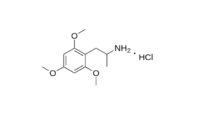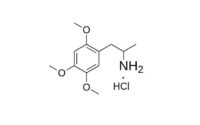TMA-4 synthesis
This is classical synthesis method of TMA-4 was criated with help of experts from BB forum.
To a solution of 68 g 2,4-dimethoxybenzaldehyde (1) in 250 mL glacial acetic acid that had been warmed to 25 °C and well stirred, there was added, dropwise, 86 g of a 40% peracetic acid solution (in acetic acid). The reaction was exothermic, and the rate of addition was dictated by the need to maintain the internal temperature within a few degrees of 28 °C. External cooling was used as needed. The addition took 1 h, and when the reaction had clearly been completed (no further temperature rise) the entire reaction mixture was added to 3 volumes of H2O. The excess acid was neutralized with solid K2CO3 (283 g were required). This was extracted with 3×100 mL Et2O, the extracts pooled, and stripped of solvent under vacuum to give 66 g of crude 2,4-dimethoxyphenyl formate (2).

This (2) was suspended in 125 mL 10% NaOH, and the mixture heated on the steam bath for 1.5 h. On cooling, the reaction mixture set to a heavy black solid. This was removed by filtration, washed with H2O, and dissolved in 250 mL CH2Cl2. The organic phase was washed with dilute HCl, and then with aqueous NaHCO3, which removed much of the color. Removal of the solvent under vacuum gave a deep red goo that was dissolved in 200 mL anhydrous Et2O and filtered through paper. The resulting clear solution was stripped of solvent, yielding 34.4 g of 2,4-dimethoxyphenol (3) as a red oil that crystallized on cooling. A 1.0 g sample in 4 mL pyridine was treated with 0.9 g benzoyl chloride and heated on the steam bath for a few min. The addition of H2O gave a pasty solid that was isolated by pressing on a porous plate. The yield of crude 2,4-dimethoxyphenyl benzoate was 1.1 g. Recrystallization from cyclohexane gave a white product with a mp of 86-87 °C. A second recrystallization from cyclohexane raised this to 89-90 °C, which is in agreement with the literature value.

To a solution of 31.0 g crude 2,4-dimethoxyphenol (3) in 60 mL absolute EtOH there was added a solution of 11.25 g KOH in 90 mL boiling EtOH. To this, there was then added 28 g allyl bromide which produced an immediate white precipitate of KBr. The mixture was held at reflux for 2 h and then quenched in 3 volumes of H2O. Sufficient 10% NaOH was added to make the reaction strongly basic, and this was extracted with 3×100 mL Et2O. Removal of the solvent under vacuum gave 33.2 g of 1-allyloxy-2,4-dimethoxybenzene (4), shown to be free of phenol starting material by GC analysis. Analyses must be carried out at low column temperatures (below 180 °C) on an ethylene glycol succinate substrate. If a silicone column is used, even at these low temperatures, there is considerable Claisen rearrangement taking place on the column. Low temperature distillation can be used for further purification (107-110 °C at 1.0 mm/Hg).

A 31.0 g sample of 1-allyloxy-2,4-dimethoxybenzene (4) was gently heated with a soft flame until the internal temperature reached 215 °C. An exothermic reaction took place, with the temperature rising to 270 °C. The residue left in the flask was largely 2-allyl-4,6-dimethoxyphenol (5), that contained perhaps 10% of 2,4-dimethoxyphenol which resulted from the pyrolytic loss of the allyl group. This mixture was methylated without further purification.

To a solution of 30 g impure 2-allyl-4,6-dimethoxyphenol (5) in a little absolute EtOH there was added a boiling solution of 8.7 g KOH in 75 mL absolute EtOH followed, immediately, by 22.4 g methyl iodide in a little EtOH. The mixture was held at reflux for 3 h, then added to 4 volumes of H2O. Sufficient 10% NaOH was added to make the mixture strongly basic, and this was extracted with 4×100 mL Et2O. Removal of the solvent gave 28 g of 1-allyl-2,3,5-trimethoxybenzene (6). GC analysis showed some 10% of the expected impurity, 1,2,4-trimethoxybenzene.

To a solution of 26 g crude 1-allyl-2,3,5-trimethoxybenzene (6) in an equal weight of absolute EtOH there was added 52 g of flaked KOH. The mixture was heated on the steam bath overnight, and then quenched with much H2O. This was extracted with 3×100 mL Et2O which, on removal under vacuum gave 24.6 g of product. This contained, by GC analysis, largely cis- and trans-1-propenyl-2,3,5-trimethoxybenzene and the expected 1,2,4-trimethoxybenzene. This mixture was dissolved in an equal volume of pentane, and cooled in dry ice. Quick filtration gave 9.2 g of an amber solid which had a melting point of 39-41.5 °C. Recrystallization from hexane provided pure trans-1-propenyl-2,3,5-trimethoxybenzene (7) with a m.p. of 44-45 °C. Evaporation of the original pentane mother liquor provided an impure sample of mixed cis- and trans- isomers.

A solution of 7.2 g trans-1-propenyl-2,3,5-trimethoxybenzene (7) in 41 g dry acetone was treated with 3.3 g dry pyridine and, with good stirring, cooled to 0 °C. There was then added 6.9 g of tetranitromethane over the course of 1 min, and the reaction mixture was allowed to stir for an additional 2 min. The reaction mixture was then quenched with a solution of 2.2 g KOH in 40 mL H2O. After the addition of more H2O, the product was extracted with 3×50 mL CH2Cl2. Removal of the solvent under vacuum yielded 7.0 g of an impure product which would not crystallize. This was distilled under vacuum to give four fractions, all of which crystallized spontaneously. Cuts #1 and #2 (b.p. 100-120 °C and 120-130 °C at 2 mm/Hg) were combined, weighed 0.8 g, and after crystallization from hexane yielded white crystals with a mp of 62-63 °C. The NMR spectrum (in CDCl3) was in agreement with 2,3,5-trimethoxybenzaldehyde, and the literature mp has been reported as being 62-63 °C. Cuts #3 and #4 (b.p. 130-170 °C and 170-175 °C at 2 mm/Hg with the bulk coming over in the latter fraction) were combined to give 3.0 g of yellow crystals. These were triturated under a little cold MeOH, and then recrystallized from MeOH to give 1.15 g of yellow crystals of 2-nitro-1-(2,3,5-trimethoxyphenyl)propene (8), with a m.p. of 87-88 °C. The forerun of the distillation contained considerable unreacted trans-1-propenyl-2,3,5-trimethoxybenzene and some 1,2,4-trimethoxybenzene, by GC analysis.

To a refluxing and stirred suspension of 1.1 g LAH in 150 mL anhydrous Et2O and under Et2O, there was added a solution of 1.1 g 2-nitro-1-(2,3,5-trimethoxyphenyl)propene (8) in 50 mL anhydrous Et2O. The creamy mixture was held at reflux for 4 h, cooled, and then the excess hydride cautiously destroyed by the addition of 1.5 N H2SO4. There was then added 20 g potassium sodium tartrate followed by sufficient aqueous NaOH to raise the pH to >9. The Et2O phase was separated, and the remaining aqueous phase extracted with 3×75 mL CH2Cl2. The organic phase and extracts were combined, and the solvent removed under vacuum yielding 0.9 g of a colorless oil. This was dissolved in 200 mL anhydrous Et2O which was saturated with anhydrous HCl gas. There was generated a thick oil that did not crystallize. The Et2O was decanted from this, and allowed to stand for several days in a sealed container at room temperature. There was the deposition of fine white needles of 2,3,5-trimethoxyamphetamine hydrochloride (TMA-4) (9) weighing, after Et2O washing and air drying, 0.31 g. The m.p. was 118-119 °C. The residual oil was dissolved in H2O, made basic with NaOH, and extracted with CH2Cl2. Evaporation of the solvent gave 0.40 of a white oil which was dissolved in a little MeOH containing 0.22 g oxalic acid. There was the immediate deposition of crystals of the oxalate salt of 2,3,5-trimethoxyamphetamine, with a m.p. of about 110 °C.



